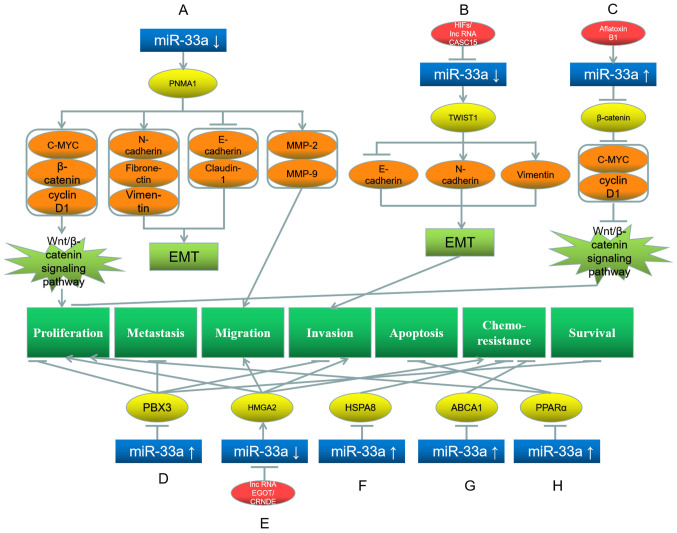Figure 1.
Roles of miR-33a and its target genes in hepatocellular carcinoma, and the underlying mechanisms. (A) miR-33a downregulation upregulates its target gene PNMA1, which further upregulates C-MYC, β-catenin, N-cadherin, fibronectin, vimentin, MMP-2 and MMP-9, while downregulates E-cadherin and claudin-1, promoting EMT, proliferation and migration. (B) HIFs and lncRNA CASC15 downregulate miR-33a and further upregulate the target gene TWIST1, which upregulates N-cadherin and vimentin, while downregulates E-cadherin, promoting EMT and invasion. (C) Aflatoxin B1 upregulates miR-33a, which inhibits its target gene β-catenin and further downstream proteins C-MYC and cyclin D1, leading to proliferation inhibition. (D) miR-33a upregulation downregulates its target gene PBX3, leading to the inhibition of proliferation, metastasis, invasion and survival. (E) LncRNA EGOT and lncRNA CRNDE downregulate miR-33a, which further upregulates its target gene HMGA2, promoting proliferation, migration, invasion and chemoresistance. (F) miR-33a upregulation downregulates its target gene HSPA8, inhibiting chemoresistance. (G) miR-33a upregulation downregulates its target gene ABCA1, inhibiting chemoresistance. (H) miR-33a upregulation downregulates its target gene PPARα, promoting proliferation and inhibiting apoptosis. Red represents the factor causing miR-33a dysregulation; blue represents miR-33a; yellow represents the target genes of miR-33a; orange represents the downstream proteins; light green represents the signaling pathways and EMT processes; dark green represents the biological processes of cancer cells. miR, microRNA; PNMA1, paraneoplastic antigen Ma1; MMP, matrix metalloproteinase; TWIST, Twist basic helix-loop-helix transcription factor 1; EMT, epithelial-mesenchymal transition; PBX3, pre-B-cell leukemia transcription factor 3; HSPA8, heat shock protein family A (Hsp70) member 8; ABCA1, ATP-binding cassette transporter A1; PPARα, peroxisome proliferator activated receptor α.

